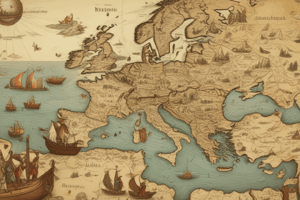Podcast
Questions and Answers
मेसोपोटेमिया में 1500 ईसा पूर्व में लेखन, पहिया और शहरों का विकास हुआ
मेसोपोटेमिया में 1500 ईसा पूर्व में लेखन, पहिया और शहरों का विकास हुआ
False (B)
विश्व युद्ध में 1945 में सोवियत संघ की स्थापना हुई
विश्व युद्ध में 1945 में सोवियत संघ की स्थापना हुई
False (B)
प्राचीन रोम में लोगों ने डेमोक्रेसी की स्थापना की
प्राचीन रोम में लोगों ने डेमोक्रेसी की स्थापना की
False (B)
रेनेसां में 18वीं शताब्दी में古典 सीखने और कला के पुनरुत्थान हुए
रेनेसां में 18वीं शताब्दी में古典 सीखने और कला के पुनरुत्थान हुए
गैलीलियो गैलीली एक राजनीतिज्ञ थे
गैलीलियो गैलीली एक राजनीतिज्ञ थे
एन्लाइटनमेंट एक 19वीं शताब्दी का बौद्धिक आंदोलन था
एन्लाइटनमेंट एक 19वीं शताब्दी का बौद्धिक आंदोलन था
विश्व में सबसे छोटा देश कौन सा है?
विश्व में सबसे छोटा देश कौन सा है?
पृथ्वी के कितने महासागर हैं?
पृथ्वी के कितने महासागर हैं?
फ्रांस में कौन सी प्रसिद्ध इमारत है?
फ्रांस में कौन सी प्रसिद्ध इमारत है?
सौर मंडल में कितने ग्रह हैं?
सौर मंडल में कितने ग्रह हैं?
चीन में कौन सी प्रसिद्ध दीवार है?
चीन में कौन सी प्रसिद्ध दीवार है?
भारत में कौन सी प्रसिद्ध इमारत है?
भारत में कौन सी प्रसिद्ध इमारत है?
Flashcards are hidden until you start studying
Study Notes
Timeline of Major Historical Events
- Ancient Civilizations:
- Mesopotamia (3500 BCE): Invention of writing, wheel, and development of cities
- Ancient Egypt (3100 BCE): Pyramids, mummification, and hieroglyphics
- Ancient Greece (8th century BCE): Democracy, philosophy, and theater
- Ancient Rome (8th century BCE): Republic, empire, and law
- Medieval Period:
- Fall of the Roman Empire (476 CE)
- Rise of Christianity and the Catholic Church
- Feudalism and the Crusades
- Early Modern Period:
- Renaissance (14th-17th centuries): Revival of classical learning and arts
- Age of Exploration (15th-17th centuries): European discovery and colonization
- Modern Era:
- Industrial Revolution (18th-19th centuries): Transition from manual labor to machine-based manufacturing
- World War I (1914-1918) and World War II (1939-1945): Global conflicts and formation of the modern world order
- Contemporary Era:
- Cold War (1945-1991): Bipolar world order and the rise of the United States and Soviet Union as superpowers
- Globalization and technological advancements (late 20th century onwards)
Significant Historical Figures
- Ancient:
- Socrates, Plato, and Aristotle (philosophers)
- Alexander the Great (conqueror)
- Medieval:
- Charlemagne (king and emperor)
- Thomas Aquinas (theologian and philosopher)
- Early Modern:
- Leonardo da Vinci (polymath and artist)
- Galileo Galilei (astronomer and physicist)
- Modern:
- Napoleon Bonaparte (emperor and military leader)
- Albert Einstein (physicist)
Historical Concepts and Processes
- Imperialism: The policy of extending a nation's authority by acquiring and dominating other territories
- Nationalism: The sentiment of national consciousness and the desire for national independence
- Revolution: A fundamental change in power or organizational structures, often accompanied by violence or radical reform
- Enlightenment: An 18th-century intellectual movement emphasizing reason, individualism, and democracy
इतिहास की प्रमुख घटनाओं का टाइमलाइन
- प्राचीन सभ्यताएं: मेसोपोटामिया (3500 ईसा पूर्व) में लेखन, पहिया और शहरों का विकास हुआ।
- प्राचीन मिस्र (3100 ईसा पूर्व) में पिरामिड, ममीकरण और हिएरोग्लिफ़िक्स का आविष्कार हुआ।
- प्राचीन ग्रीस (8वीं शताब्दी ईसा पूर्व) में लोकतंत्र, दर्शन और रंगमंच का उद्भव हुआ।
- प्राचीन रोम (8वीं शताब्दी ईसा पूर्व) में गणराज्य, साम्राज्य और विधान की स्थापना हुई।
मध्यकालीन अवधि
- रोमन साम्राज्य का पतन (476 ईस्वी)
- ईसाइयत और कैथोलिक चर्च का उद्भव
- सामन्तशाही और क्रूसेड्स का युग
प्रारंभिक आधुनिक अवधि
- पुनर्जागरण (14वीं-17वीं शताब्दी) में शास्त्रीय ज्ञान और कलाओं का पुनरूत्थान
- खोज का युग (15वीं-17वीं शताब्दी) में यूरोपीय खोज और उपनिवेशवाद
आधुनिक युग
- औद्योगिक क्रांति (18वीं-19वीं शताब्दी) में हाथ से काम करने से मशीन आधारित विनिर्माण में परिवर्तन
- प्रथम विश्वयुद्ध (1914-1918) और द्वितीय विश्वयुद्ध (1939-1945) में वैश्विक संघर्ष और आधुनिक विश्व व्यवस्था का निर्माण
समकालीन युग
- शीत युद्ध (1945-1991) में द्विध्रुवीय विश्व व्यवस्था और संयुक्त राज्य अमेरिका और सोवियत संघ के रूप में siêu शक्तियों का उद्भव
- वैश्वीकरण और प्रौद्योगिकी उन्नति (देर 20वीं शताब्दी से)
प्रमुख ऐतिहासिक व्यक्ति
प्राचीन
- सॉक्रेट्स, प्लेटो और एरिस्टॉटल (दर्शनशास्त्री)
- अलेक्जेंडर द ग्रेट (विजेता)
मध्यकालीन
- चार्लमेन (राजा और सम्राट)
- थॉमस एक्विनास (धर्मशास्त्री और दर्शनशास्त्री)
प्रारंभिक आधुनिक
- लियोनार्डो दा विंची (बहुप्रज्ञ और कलाकार)
- गैलीलियो गैलीली (खगोलविज्ञानी और भौतिकीविज्ञानी)
आधुनिक
- नेपोलियन बोनापार्ट (सम्राट और सैन्य नेता)
- अल्बर्ट आइंस्टीन (भौतिकीविज्ञानी)
ऐतिहासिक अवधारणाएं और प्रक्रियाएं
- साम्राज्यवाद: अन्य क्षेत्रों के अधीन करने और विस्तार करने की नीति
- राष्ट्रवाद: राष्ट्रीय चेतना और राष्ट्रीय स्वतंत्रता की इच्छा
- क्रांति: शक्ति या संगठनात्मक संरचना में मूल परिवर्तन, अक्सर हिंसा या радिकल सुधार के साथ
- प्रबोधन: 18वीं शताब्दी का एक बौद्धिक आंदोलन जिसमें तर्क, व्यक्तिवाद और लोकतंत्र पर जोर दिया गया
विश्व भूगोल
- महाद्वीप: 7 (अफ़्रीका, अंटार्कटिका, एशिया, ऑस्ट्रेलिया, यूरोप, उत्तरी अमेरिका, दक्षिणी अमेरिका)
- समुद्र: 5 (प्रशांत, अटलांटिक, हिन्द, आर्कटिक, दक्षिणी)
प्रसिद्ध स्थल
- आयफ़ेल टावर (पेरिस, फ्रांस)
- चीन की बड़ी दीवार (चीन)
- ताज महल (आगरा, भारत)
- गीज़ा के पिरामिड (मिस्र)
- своб्टी की मूर्ति (न्यू यॉर्क सिटी, यूएसए)
ऐतिहासिक घटनाएं
- प्रथम विश्व युद्ध: 1914-1918
- द्वितीय विश्व युद्ध: 1939-1945
- अमेरिकी क्रांति: 1765-1783
- फ़्रांसीसी क्रांति: 1789-1799
- औद्योगिक क्रांति: 18वीं-19वीं शताब्दी
विज्ञान और प्रौद्योगिकी
- सौर मंडल के ग्रह: 8 (मर्करी, शुक्र, पृथ्वी, मंगल, बृहस्पति, शनि, अरुण, Варुण)
- मानव शरीर प्रणाली: तंत्रिका, संचार, श्वास, पाचन, एंडोक्राइन
- आविष्कारक: लियोनार्डो दा विंची, गालीलियो, आइज़क न्यूटन, अल्बर्ट आइंस्टीन, टॉमस एडिसन
कला और संस्कृति
- प्रसिद्ध चित्रकार: लियोनार्डो दा विंची, विन्सेंट वान गॉग, पाब्लो पिकासो, क्लॉड मोनेट, जोहान्स वेर्मीर
- संगीत वाद्य: पियानो, गिटार, वायलिन, ड्रम, फ्ल्यूट
- साहित्यिक विधा: कथा साहित्य,-अकथा साहित्य, कविता, नाटक, प्रेम कहानी
विविध
- राजधानी शहर: टोक्यो (जापान), बीजिंग (चीन), लंदन (यूके), पेरिस (फ्रांस), वाशिंगटन डीसी (यूएसए)
- मुद्रा: यूएसडी (यूएसए), यूरो (ईयू), जेपीवाय (जापान), जीपीबी (यूके), सीएनवाई (चीन)
- लोकप्रिय खेल: फुटबॉल, बास्केटबॉल, टेनिस, क्रिकेट, वॉलीबॉल
Studying That Suits You
Use AI to generate personalized quizzes and flashcards to suit your learning preferences.




